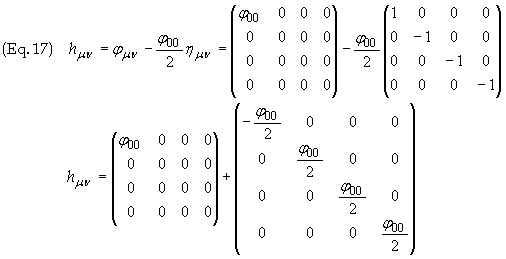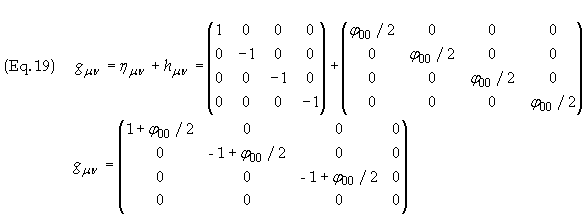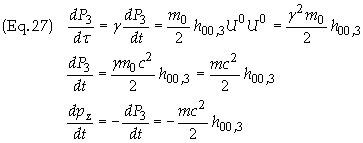Gravitational
Field of an
Infinitely Long Rod
Back
to Physics World
Back
to General Relativity
Problem: Consider an infinitely long thin rod that is at rest in frame S on the x-axis. Define r0 such that gravitational potential F is zero at that distance from the rod. I.e. F(r0) = 0.
(a) Find
the gravitational field, gmn,
in S by explicitly
solving Einstein’s weak
field equations.
(b) Find duz
/dt for u = 0, r = r0, and y
= 0 where uz
º dz/dt for a particle in free-fall. Consider
the results only in the z plane, i.e. let y = 0. Then r = z.
(c) Find dpz
/dt for u
º
|u| (relativistic speed), r = r0,
and y = 0 for a particle in free-fall.
Solution (a):
Let the linear proper mass density (mass per unit length) of the rod in S be
l0.
The Newtonian gravitational
potential of the rod for y = 0 is given by
![]()
C is a constant of
integration. This result may be obtained from the weak
field limit of Einstein equations and gauge condition, i.e. respectively

Since all matter in the S
frame is motionless then we expect the gravitational field to be time
independent. Therefore since the energy-momentum tensor vanishes outside the rod
we obtain from Eq. (2a)
![]()
where fmn
are defined as

In cylindrical coordinates

Due to rotational symmetry the fmn will be a function of r only. Thus

Therefore the term inside the parentheses is constant. Let these constants be Cmn. Then
![]()
The solution is obtained
directly from integration to obtain
![]()
The gauge condition from
Eq. (2b) becomes

Eq. (8) must be valid for
all values of xk
which can only be true if Cmn
= 0. The only non-vanishing
value must be C00.
Therefore only
![]()
does not vanish. Thus we
arrive at Eq. (1). To determine C00
recall
![]()
where
![]()
Thus the 00 component of
Eq. (10) becomes
![]()
h00
is related to the Newtonian potential as
![]()
Comparing Eq. (1), (12)
and Eq. (13) shows that
![]()
We then have from Eq. (9)
![]()
The other components of h00 are found from Eq. (10)

Upon substitution of Eq. (16) we can simplify Eq. (17) to

The metric tensor gmn is related to hmn by

Therefore we find the
final expression for the field by substituting Eq. (16) into Eq. (19) to obtain
the result

C
is chosen such that F(r0)
and therefore g00(r0)
= 1. I.e. C º -4Gl0ln
r0.
Thus the coordinate clock is located at r = r0
Solution
(b): By assumption
U1 = U2
= U3 = 0, r = r0,
and y
= 0. It
can be shown that
![]()
At r = r0, z = 0, for u = 0 dt/dt = 1. U3 = -uz and U0 = c. Eq. (19) then becomes


Warning: Eq. (23) may not appear to be correct. When this page was originally posted the result obtained was h00,3 = 4Gl0/c2z. This will be the value used from herein. The problem will be corrected at a later date.
The last part follows due
to the fact that y = 0 and therefore r = z. The final
result is therefore

Solution
(c): By assumption u is relativistic, r = r0,
and y = 0. At r = z = 0, for u relativistic
and in the weak field limit

To find dpz/dt
note that U0 = cg
and pz
= P3
= -P3. Eq. (21) then becomes upon multiplying through by
the proper mass m0
to obtain
![]()

Recall the
value of h00
found in Eq. (18), i.e. h00
= 4Gl0ln
z. The result h00,3
was calculated above
in Eq. (23) giving h00,3
= 4Gl0/c2z.
The last part follows due to the fact that y = 0 and therefore r
= z. The final result is therefore

m
= gm0
is the mass of the particle whose proper mass is m0.
Back to General Relativity
Back
to Physics World